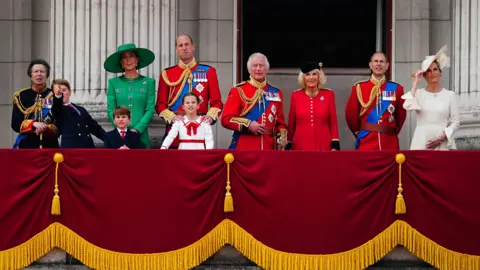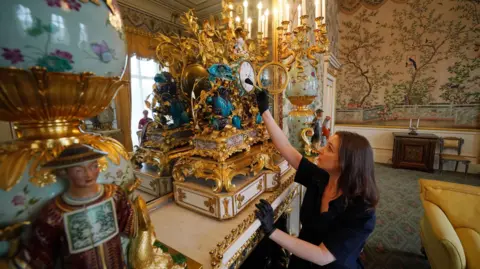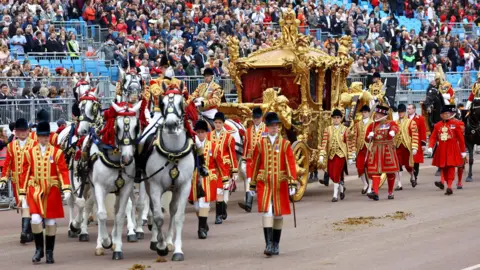Public funding for royals triples since 2012 because of Palace works
 PA Media
PA MediaPublic funding for the Royal Household has tripled in real terms since 2012, official figures show, with the rise driven largely by repairs and building work at Buckingham Palace.
The Sovereign Grant, which provides taxpayer support for the monarchy, was introduced in 2012 at £31m per year. That has now risen to £132m, data from the House of Commons Library shows, and once inflation has been taken into account, that represents about a threefold increase.
The grant rose 53% in April, from £86.3m to £132.1m. Royal aides say this was because of a Buckingham Palace building project and the grant will come down again, adding that the monarchy represents good value.
Lord Turnbull, a crossbench peer and a former Cabinet Secretary, called the way the grant was calculated "complete and utter nonsense" but said that the budget isn't high compared with other presidential heads of state.
The Sovereign Grant provides funding for the official duties of the monarchy. In the most recent figures, for 2023-24, the biggest items were property maintenance and staff payroll, with smaller amounts for travel and hospitality and housekeeping.
The analysis by the House of Commons Library shows how much the Sovereign Grant has risen over time - using a measure that takes into account inflation, with comparisons using 2023-24 values as a benchmark.
Using that measure, the Sovereign Grant in 2012-13 was worth £41.5m – which rose to almost £100m in 2018-19, to cover renovations in Buckingham Palace, and then rose in 2025-26 to being worth £129.3m, again for work on Buckingham Palace.
A Bank of England inflation calculation also shows the grant's value having trebled since 2012, although Buckingham Palace uses a separate figure which is slightly below a threefold real-terms increase.
Buckingham Palace says the current figures are higher because of a 10-year, £369m project to modernise facilities in the Palace, including cabling, plumbing, wiring and lifts. It's a project that the National Audit Office says has been well-run and delivers "good value for money".
The Palace says it's misleading to compare this year's figures with earlier levels of grants. They say the big increase is due to the element of the grant that pays for Buckingham Palace building works, rather than the "core" grant for other running costs.
"The Sovereign Grant remained virtually flat for five years from 2020, during a period of high inflation. The majority of the increase in this year's Sovereign Grant is to fund the Buckingham Palace Reservicing Programme, which is ensuring that the Palace, a national asset, is accessible and protected from fire and flood," said a Palace spokesperson.
"A temporary increase in the grant across two years was approved to provide the remainder of the funding agreed in 2016 for this reservicing work. It has always been anticipated that the level of the Sovereign Grant will drop once the project is completed," said the spokesperson.
This could mean taxpayer funding reducing after 2027.
 PA Media
PA MediaThe sharp increase over the past decade has been during difficult years for public finances, including periods of austerity and tight controls over budgets.
For example, a report from the Institute for Fiscal Studies showed that public spending on education in England went down by 11% in real terms between 2010-11 and 2023-24, although the IFS says that it is difficult to compare such big multi-billion budgets with changes in relatively smaller amounts such as the Sovereign Grant.
Before the Sovereign Grant was introduced, state funding for the monarchy came through a mix of grants, government department spending and a "civil list" payment.
Figures from the House of Commons Library, going back to 1995, show the pre-Sovereign Grant totals as lower than than they are today - for instance, using 2023-24 values, it was worth £67m in 2000 and £56m in 2005.
The Sovereign Grant was introduced as a more "modern, transparent" way of bringing together royal funding, presented to MPs in 2011 as being likely to reduce the royal income.
The grant is based on a percentage of the profits of the independent property and landowning business, the Crown Estate. The grant is not from the Crown Estate, it comes from the Treasury, but the Crown Estate is used as a benchmark.
Sovereign Grant was initially set at 15% of Crown Estate profits, which rose to 25% to cover the cost of renovating Buckingham Palace.
It's now being reduced to 12%. But because of increased profits for the Crown Estate from selling leases for offshore wind farms, the actual cash amount has risen sharply, because it's a percentage based on a much bigger total.
The increase in the Sovereign Grant's value is blamed by former Lib Dem Home Office minister Norman Baker, a prominent critic of royal finances, on what he calls the "completely absurd" way it's calculated and "weak-kneed" governments that don't want to challenge it.
"The Royal Family has been very efficient in persuading the public purse to keep coughing up more money," he says.
"Buckingham Palace has been used again and again to justify the increases.
"We're told public finances are tight, we can't afford a winter fuel allowance, but we can pay for an increase for the Royal Family. It's completely wrong."
 PA Media
PA MediaLord Turnbull, a former Cabinet Secretary and Permanent Secretary at the Treasury in the 1990s and 2000s, is also critical of the way the grant is calculated. He says successive governments have used the Crown Estate calculation as a convenient way of avoiding debate and stopping a "lot of bolshy backbenchers moaning about the cost of the monarchy".
He says it would be much better to have a straightforward grant to pay for the monarchy, which could be debated on its own merits.
But he also says it's a "red herring" to focus on the headline increase in the Sovereign Grant, when that figure has been driven by work to preserve Buckingham Palace, rather than underlying running costs. He says that if you have a monarchy it has to be properly funded. "You either have one or you don't," says Lord Turnbull.
Pauline Maclaran, a royal commentator from Royal Holloway, University of London, says the monarchy "generates a great deal of money and goodwill."
This is often seen in terms of boosting tourism and promoting business links, but Prof Maclaran says increasingly it needs to recognise the impact of royal "soft power".
US President Trump is a self-professed fan of King Charles and if those warm feelings helped with UK and US trade and tariff negotiations the benefits would hugely outweigh any annual costs of the monarchy, says Prof Maclaran.
 PA Media
PA MediaBut the royals can't be immune to questions about finances, she says: "The public wants to know if they're of value."
Royal expert Richard Palmer says this year's increase has "raised eyebrows".
"Of course the head of state and those who support him need to be funded properly, but so do other parts of the state - the health service, schools, the military, for example," says Mr Palmer.
Royal sources say there is transparency and funding is subject to the approval of Parliament. The Royal Trustees overseeing the grant are the prime minister, chancellor and the keeper of the privy purse, who looks after the monarch's finances.
You can dig into the accounts and see from 2023-24 that the royals spent over £1m on helicopter flights, there was an electricity bill of £2.2m and that travel for the Duke of Kent over three days to attend regimental events in Scotland cost more than £23,000.
There are also details of what the monarchy provides in a year – including hosting 400 events, inviting 105,000 guests to receptions, garden parties and official lunches. There were also 2,300 public engagements, supporting charities and good causes.
There are national and international events, including state visits which help to promote UK trade. There's a constitutional role, such as the state opening of Parliament and regular meetings with the prime minister.
Republic, a group campaigning for an elected head of state, have argued that other costs need to be included, such as security, which is not covered by the Sovereign Grant.
They also want the Duchies of Lancaster and Cornwall to count as public funding, rather than private incomes for the King and Prince of Wales. A report from the group claims that the total cost of the monarchy is about £510m per year.
Opinion polls suggest the monarchy remains popular, with a YouGov survey in February 2025 suggesting 55% viewed the monarchy positively compared with 36% who saw it negatively.
But there is less certainty about funding. Another YouGov survey in December 2024 suggested strong public opposition to government money being spent on Buckingham Palace – by 56% to 29%.
And there are divisions by age groups – with 74% of the over-65s thinking the royals are good value for money, compared with 44% of 25 to 49 year olds.

Sign up here to get the latest royal stories and analysis every week with our Royal Watch newsletter. Those outside the UK can sign up here.
